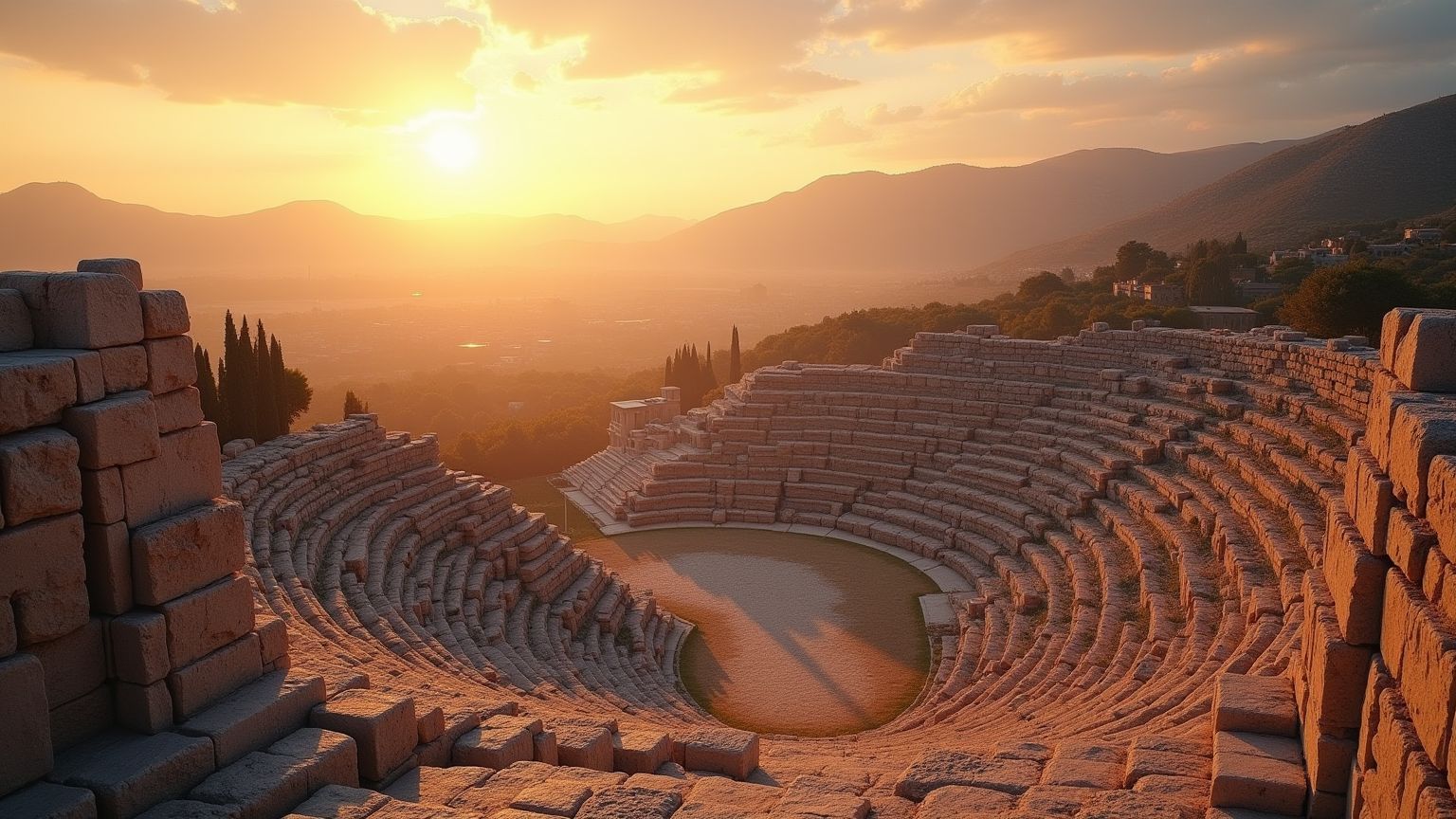Mycenaean Mythology: Walking Through the Gates of Ancient Kings
God, I still remember that old man's face - a 70-something American visiting Mycenae for the first time. Tears streaming down his weathered cheeks as he touched the Lion Gate. "I've waited my whole life for this," he whispered. After 23 years guiding folks through these stones, those moments still get me.
The Magnificent Ruins of Mycenae: A Historical Overview
Mycenae isn't just sitting on a hill - it's practically swaggering between two mountains in the northeastern Peloponnese, about 90km from Athens. Trust me, even the most Instagram-obsessed teenager stops mid-selfie when they first see it.
The raw power of Mycenaean mythology hits you the second you round that final bend in the road. I always make everyone pause before entering. "Take a deep breath," I tell them. "You're about to step 3,500 years backwards."
This wasn't just some ancient village - Mycenae was the beating heart of Mycenaean mythology and civilization from 1600 to 1100 BCE. During its golden years (1350-1200 BCE), these folks weren't just influential; they were the Mediterranean's superpower.
Remember Heinrich Schliemann? That stubborn, wealthy German who showed up in 1876 utterly convinced Homer wasn't just spinning yarns? His methods make modern archaeologists cringe (sledgehammer archaeology, I call it), but boy did he strike gold - literally! That famous "Mask of Agamemnon" he uncovered has launched a thousand history textbook covers.
The most jaw-dropping features? Those "Cyclopean walls" surrounding the citadel. Picture limestone blocks heavier than your car - some weighing over 20 tons - fitted together so perfectly that the ancient Greeks figured only one-eyed giants could've managed it. Even after two decades here, I still can't wrap my head around how they moved these monsters with Bronze Age technology.
Inside the Citadel: What You'll Experience Today
- Lion Gate: Europe's oldest monumental sculpture, standing guard since 1250 BCE. Those weathered lionesses have seen things your history books only hint at.
- Palace Complex: Just foundations now, but close your eyes at the megaron and you can almost smell the olive oil lamps burning as kings held court.
- The Underground Cistern: My personal favorite! 99 slippery steps descending into darkness, leading to the spring that saved countless lives during sieges. (I've seen grown men chicken out halfway down this passage!)
- Tholos Tombs: The "Treasury of Atreus" will make your neck hurt from looking up. Its dome remained the world's largest until the Romans built the Pantheon. Not bad for "primitive" builders, eh?
I love taking folks to Grave Circle B - most guides skip it. Discovered in 1951, it's older and more intimate than the famous Grave Circle A. Standing by these 26 shaft graves dating back to 1650 BCE, surrounded by wildflowers in spring, you can almost hear the Mycenaean mythology whispers from those early burial rituals.
Mycenaean Mythology: Where Legends Were Born

At Mycenae, history and Mycenaean mythology slow-dance together so closely you can't tell where one ends and the other begins.
According to the old stories, Perseus himself (yes, that Perseus - Zeus's boy who beheaded Medusa) founded this place. Dropped his sword pommel (mykes) here, or maybe drank from a mushroom-shaped spring (also mykes). Either way, the gods basically GPS-directed him to this exact hilltop.
But the juicy stuff in Mycenaean mythology involves the House of Atreus. Hoo boy! Makes your favorite Netflix drama look like Sesame Street. We're talking epic family dysfunction:
Atreus and Thyestes: Brothers who hated each other's guts. Atreus eventually served Thyestes his own children as "reconciliation" dinner. Worst. Barbecue. Ever.
Then comes Agamemnon, Atreus's son and star of Mycenaean mythology's greatest hit: the Trojan War. This guy sacrificed his daughter Iphigenia just to get some favorable sailing winds! No "Father of the Year" awards in his future.
While he's off besieging Troy for a decade, his wife Clytemnestra shacks up with Aegisthus (Thyestes' revenge-seeking son). When Agamemnon finally comes home victorious, they axe him - literally - either in his bathtub or at dinner, depending which version of Mycenaean mythology you prefer.
Standing by the palace ruins on windy afternoons, I swear you can sometimes hear echoes of that ancient betrayal. The complete Mycenaean mythology cycle continues with Orestes (Agamemnon's son) killing his mother and her lover, then being hunted by the Furies until Athena finally says "enough already!"
Wild as these Mycenaean mythology tales seem, excavations have shown violent upheavals did mark Mycenae's history. These blood-soaked myths might actually preserve memories of real dynastic chaos.
The Decline of Mycenae: Theories and Evidence
The most haunting question visitors ask: What the hell happened to these people?
Around 1200 BCE, something catastrophic slammed Mycenae and other centers of Mycenaean mythology and culture. The archaeological evidence is brutal - widespread burning, abandoned palaces, cultural regression that would make your skin crawl.
Was it those mysterious "Sea Peoples" Egyptian records mention? Climate change leading to famine? Earthquakes? Internal rebellion? I've heard passionate arguments from archaeologists who'd practically duel over their pet theories about what ended the civilization celebrated in Mycenaean mythology.
The site limped along afterward - a shadow settlement during the Iron Age, a curiosity in Classical times. By the 2nd century CE, poor Pausanias was basically an ancient version of me, leading tourists around ruins already ancient in his time.
Visiting Mycenae: Practical Information
After 8,000+ tours, here's what you really need to know to visit the homeland of Mycenaean mythology:
• Hours: Summer 8AM-8PM, Winter 8:30AM-3:30PM
• Damage to your wallet: €12 for adults (includes the museum)
• When to come: Early morning or late afternoon (midday sun is BRUTAL)
• What to bring: Water bottle, hat, sunblock, sturdy shoes, and curiosity
• Accessibility: Partial. Museum's fine, citadel requires uphill walking
• Time needed: Minimum 2 hours to truly appreciate Mycenaean mythology sites
• Pro move: Combine with Epidaurus or Nafplio for an epic day
The Enduring Legacy of Mycenae
Last summer, I watched a young woman sit silently on a stone block for nearly an hour, journal open but unwritten. Later she told me, "It's like their hands are still on these stones."
That's Mycenae's magic. The people who created these monuments and inspired Mycenaean mythology worried about harvests and security and leaving something meaningful behind - just like us.
Their gold work - those delicate octopuses and butterflies in the museum - reveals souls who found beauty essential even in wartime. The engineering feats of Mycenaean mythology's homeland show problem-solvers who'd have killed it in today's tech startups.
Every single day, I watch people from around the world touch these ancient walls. Their fingers trace the same stones that witnessed the real events behind Mycenaean mythology - the triumphs and tragedies that inspired Homer and still resonate in our books, movies, and psyches.
As Pindar wrote, "Great deeds give rise to great stories." At Mycenae, birthplace of Mycenaean mythology, both the deeds and the stories still pulse with life, waiting for you to become part of their continuing story.








